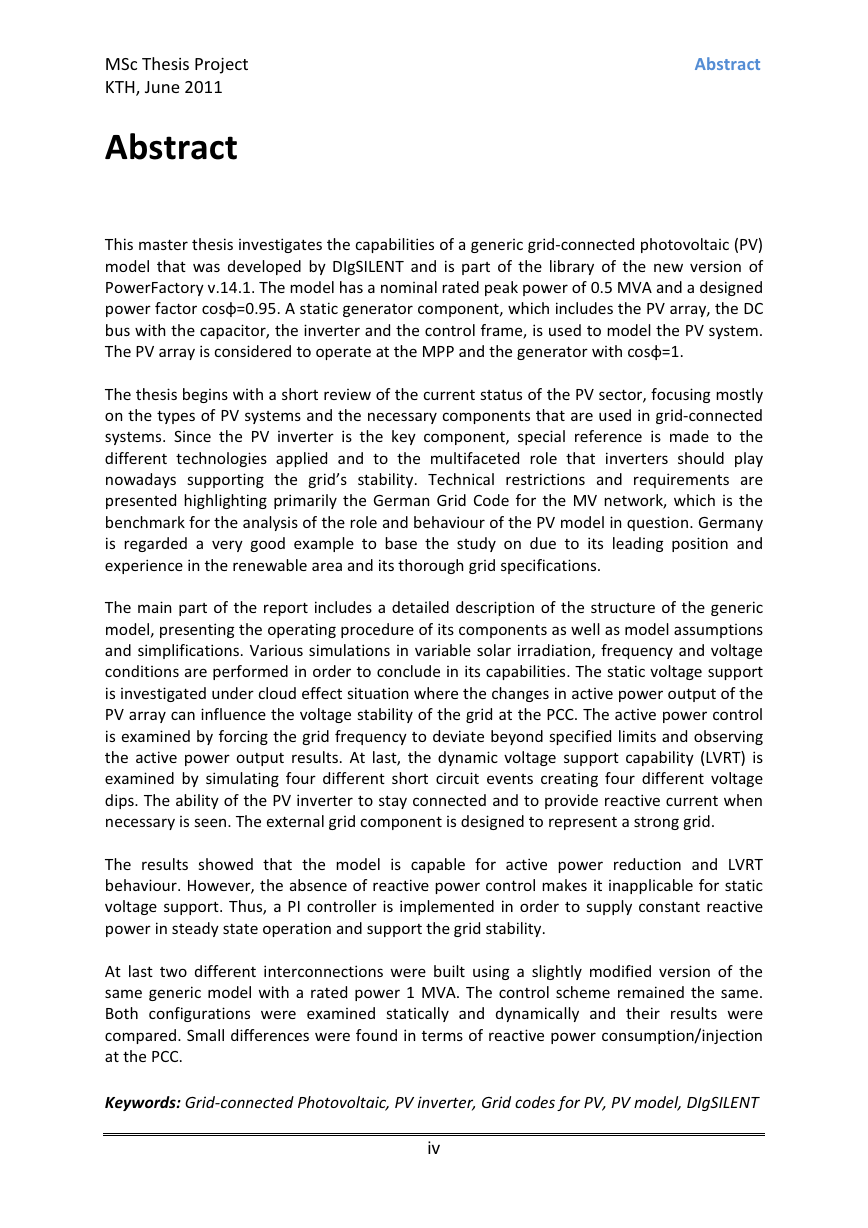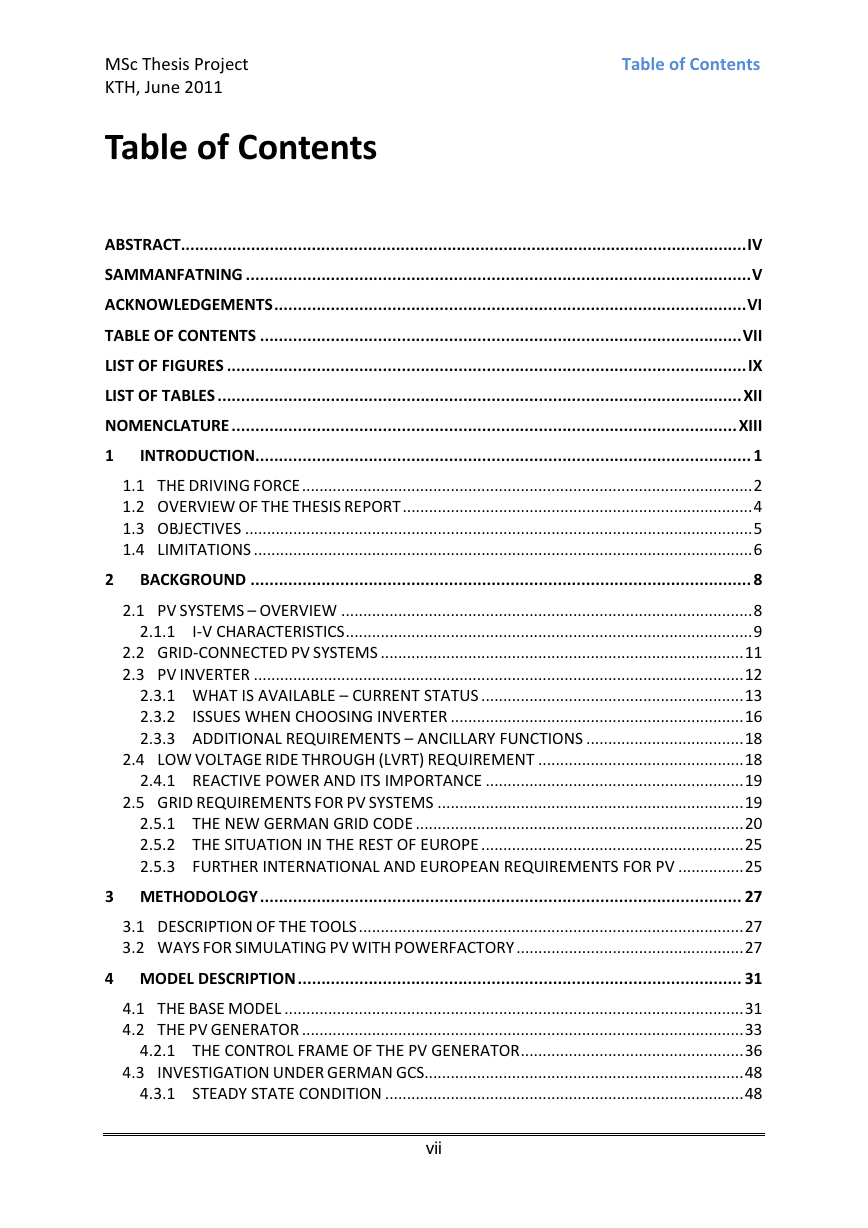Comparison of existing PV models and
possible integration under EU grid
specifications
Ioannis-Thomas K. Theologitis
Degree project in
Electric Power Systems
Second Level
Stockholm, Sweden 2011
XR-EE-ES 2011:011
�
Comparison of existing PV models and
possible integration under EU grid
specifications
Ioannis-Thomas K. Theologitis
Master of Science Thesis
KTH School of Electrical Engineering
Division of Electrical Power Systems EPS-2011
SE-100 44 STOCKHOLM
�
COMPARISON OF EXISTING PV MODELS AND
POSSIBLE
INTEGRATION UNDER EU GRID
SPECIFICATIONS
Ioannis-Thomas Theologitis
Royal Institute of Technology (KTH), Sweden
©2011
School of Electrical Engineering
Kungliga Tekniska Högskolan
SE-100 44 Stockholm
Sweden
The author is officially enrolled to the Sustainable Energy Engineering Master Program
(SEE) and belongs to the School of Industrial Engineering and Management and the
Department of Energy Technology.
The picture of the front cover is taken from the second edition of the book “Planning &
Installing Photovoltaic Systems – A guide for installers, architects and engineers”, published
by Earthscan and copyrighted by The German Energy Society (Deutsche Gesellshaft für
Sonnenenergie (DGS LV Berlin BRB) in 2008. ISBN-13: 978-1-84407-442-6
�
“Αποσκότισόν με”
-Διογένης-
“Take me out of the dark”
-Diogenes-
It was the answer to Great Alexander, when he stood in front of Diogenes and asked him what favour
he needs. Diogenes, as a cynic philosopher, answered this phrase to Alexander implying that he was
blocking the sun with his body. Cynics believed that the happiness is hidden in simple things as the
energy and warmth of the sun and not in material goods.
�
MSc Thesis Project Abstract
KTH, June 2011
Abstract
This master thesis investigates the capabilities of a generic grid-connected photovoltaic (PV)
model that was developed by DIgSILENT and is part of the library of the new version of
PowerFactory v.14.1. The model has a nominal rated peak power of 0.5 MVA and a designed
power factor cosφ=0.95. A static generator component, which includes the PV array, the DC
bus with the capacitor, the inverter and the control frame, is used to model the PV system.
The PV array is considered to operate at the MPP and the generator with cosφ=1.
The thesis begins with a short review of the current status of the PV sector, focusing mostly
on the types of PV systems and the necessary components that are used in grid-connected
systems. Since the PV inverter is the key component, special reference is made to the
different technologies applied and to the multifaceted role that inverters should play
nowadays supporting the grid’s stability. Technical restrictions and requirements are
presented highlighting primarily the German Grid Code for the MV network, which is the
benchmark for the analysis of the role and behaviour of the PV model in question. Germany
is regarded a very good example to base the study on due to its leading position and
experience in the renewable area and its thorough grid specifications.
The main part of the report includes a detailed description of the structure of the generic
model, presenting the operating procedure of its components as well as model assumptions
and simplifications. Various simulations in variable solar irradiation, frequency and voltage
conditions are performed in order to conclude in its capabilities. The static voltage support
is investigated under cloud effect situation where the changes in active power output of the
PV array can influence the voltage stability of the grid at the PCC. The active power control
is examined by forcing the grid frequency to deviate beyond specified limits and observing
the active power output results. At last, the dynamic voltage support capability (LVRT) is
examined by simulating four different short circuit events creating four different voltage
dips. The ability of the PV inverter to stay connected and to provide reactive current when
necessary is seen. The external grid component is designed to represent a strong grid.
The results showed that the model is capable for active power reduction and LVRT
behaviour. However, the absence of reactive power control makes it inapplicable for static
voltage support. Thus, a PI controller is implemented in order to supply constant reactive
power in steady state operation and support the grid stability.
At last two different interconnections were built using a slightly modified version of the
same generic model with a rated power 1 MVA. The control scheme remained the same.
Both configurations were examined statically and dynamically and their results were
compared. Small differences were found in terms of reactive power consumption/injection
at the PCC.
Keywords: Grid-connected Photovoltaic, PV inverter, Grid codes for PV, PV model, DIgSILENT
iv
�
MSc Thesis Project Sammanfatning
KTH, June 2011
Sammanfatning
Det här examensarbetet undersöker förmågan av en generisk nätanslutna solcell (PV)
modell som utvecklades av DIgSILENT och det är en del av biblioteket av den nya versionen
av PowerFactory v.14.1. Modellen har en nominell beräknat maximal effekt på 0.5 MVA och
en utformad effektfaktor på cosφ=0.95. En stillastående generator beståndsdel, som
innehåller PV uppställningen, DC bussen med kondensatorn, strömväxlaren och kontroll
ramen, som användes för att utforma PV systemet. PV uppställningen förväntas att
användas vid MPP-en och generatorn med cosφ=1.
Examensarbetet inleder med en kort genomgång av det nuvarande läget av PV sektorn, som
fokus för det mesta på PV system sorter och de viktiga beståndsdelarna som användas i
nätanslutna system. Eftersom PV strömväxlaren är den viktigaste beståndsdelen, är särskild
hänvisning görs till de olika tillämpade tekniker och den mångfacetterade roll som
växelriktare bör spela nuförtiden stödja nätets stabilitet. Tekniska begränsningar och krav
presenteras för att belysa främst på den tyska GC för MV nätet, vilket är utgångspunkten för
analysen av den roll och beteende av PV modellen i fråga. Tyskland anses ett mycket bra
exempel att basera studien på grund av sin ledande ställning och erfarenhet inom förnybar
området och dess grundliga specifikationer nätet.
Den huvuddelen av rapporten innehåller en detaljerad beskrivning av strukturen för den
generiska modellen, som presenterar fungerande förfarandet av dess komponenter samt
modellantaganden och förenklingar. Olika simuleringar i varierande solstrålning, frekvens
och spänning villkor utförs i syfte att ingå i sin förmåga. Den statiska spänningen
understödet undersökas under moln effekt situation där förändringar i aktiv uteffekt PV
uppställningen kan påverka spänningsstabilitet i rutnätet på den PCC. Den aktiva effekten
kontroll undersöks genom att tvinga nätfrekvens att avvika utöver angivna gränsvärden och
observera det aktiva resultatet uteffekt. Äntligen är den dynamiska spänning stöd kapacitet
(LVRT) undersöks med hjälp av simulerad fyra olika kortslutning händelser skapa fyra olika
spänningsfall. Förmågan hos PV strömväxlaren att hålla kontakten och ge reaktiva
strömmen vid behov ses. Det externa komponent i nätet utformats för att representera en
stark rutnät.
Resultaten visas att modellen har kapacitet för aktiv effekt minskning och LVRT beteende.
Men gör det saknas styrning av reaktiv effekt inte tillämpas under statisk spänning stöd.
Därför är en PI-regulator som genomförs för att leverera konstant reaktiv effekt i konstant
drift och support för stabila nät.
Äntligen två olika sammankopplingar byggdes med en något modifierad version av samma
generiska modell med en nominell effekt 1 MVA. Kontrollschemat förblevs densamma. Båda
konfigurationerna undersöktes statiskt och dynamiskt och resultaten jämfördes. Små
skillnader fanns i form av reaktiv effekt förbrukning / insprutning i PCC.
Nyckelord: Nätanslutna solcell, PV strömväxlare , Nät koder för PV, PV modell, DIgSILENT
v
�
last
friendly and highly professional environment.
MSc Thesis Project Acknowledgements
KTH, June 2011
five months, ensuring a
Acknowledgements
At first I wish to thank all the people, who, in whichever way, assisted me to complete this
interesting project for my master thesis and made this period an important benchmark for
my future professional expectations. From Energynautics GmbH1, Dr Thomas Ackermann,
who gave me the opportunity to complete the thesis in his company, Dr Eckehard Tröster,
for his patience with all my questions, his valuable advices and insight that gave direction to
my work, Rena Kuwahata, who was the initial contact with the company and the person that
facilitated my work and life in the new environment, Dr Nis Martensen and Stanislav
Cherevatskiy, who shared their experiences in the field whenever those were asked for and
in general I wish to thank all the rest of the personnel, who were part of my everyday life
the
Furthermore, I would like to thank Prof. Lennart Söder for the fruitful pre-presentation and
his valid comments and of course Giannis Tolikas for undertaking the translation of the
abstract to Swedish. Since it is likely that I forget some people that offered their helped for
the completion of this project, I feel obliged to thank them as well.
Special thanks should be paid to Panagiotis Giagkalos and Kyriakos Liotsios, who were my
classmates, colleagues, but most of all my friends during the last two years of this master. It
is important to realize that anytime you can find people that you can count on. May this
friendship lasts and don’t leave time and distance to wear it, rather strengthen it through
personal or professional common experiences.
To Angela Maria Castaño Garcia, for this beautiful journey that still goes on. Her support
during this time was more that I could ask for. As far as the thesis concerned, her
contribution and effort to the final format of the report was significant.
At last, to my beloved family, my parents Konstantinos and Efterpi, and my brother
Charalampos, who deserve my eternal gratitude for all that have offered me. Their constant
support in every aspect is scarcely reflected on these few sentences here. However, any
success in my life so far is mostly charged to them and consequently any success in the
future will have their signature as well.
Such moments, I feel the need to give space and mention all the people that left something
valuable to me. Old friends from Greece that never forget, new friends from different parts
of the world, people I met for short period, all of them are the people that with one way or
another made this time worth living it again. You are my personal ark. Thank you all and
wish you the best.
1 http://www.energynautics.com/
vi
�
MSc Thesis Project Table of Contents
KTH, June 2011
Table of Contents
ABSTRACT........................................................................................................................ . IV
SAMMANFATNING ........................................................................................................... V
ACKNOWLEDGEMENTS .................................................................................................... VI
TABLE OF CONTENTS ...................................................................................................... VII
LIST OF FIGURES .............................................................................................................. IX
LIST OF TABLES ............................................................................................................... XII
NOMENCLATURE ........................................................................................................... XIII
1
INTRODUCTION ......................................................................................................... 1
1.1 THE DRIVING FORCE ....................................................................................................... 2
1.2 OVERVIEW OF THE THESIS REPORT ................................................................................ 4
1.3 OBJECTIVES .................................................................................................................... 5
1.4 LIMITATIONS .................................................................................................................. 6
2
BACKGROUND .......................................................................................................... 8
2.1.1
2.1 PV SYSTEMS – OVERVIEW .............................................................................................. 8
I-V CHARACTERISTICS ............................................................................................. 9
2.2 GRID-CONNECTED PV SYSTEMS ................................................................................... 11
2.3 PV INVERTER ................................................................................................................ 12
2.3.1 WHAT IS AVAILABLE – CURRENT STATUS ............................................................ 13
2.3.2
ISSUES WHEN CHOOSING INVERTER ................................................................... 16
2.3.3 ADDITIONAL REQUIREMENTS – ANCILLARY FUNCTIONS .................................... 18
2.4 LOW VOLTAGE RIDE THROUGH (LVRT) REQUIREMENT ............................................... 18
2.4.1 REACTIVE POWER AND ITS IMPORTANCE ........................................................... 19
2.5 GRID REQUIREMENTS FOR PV SYSTEMS ...................................................................... 19
2.5.1 THE NEW GERMAN GRID CODE ........................................................................... 20
2.5.2 THE SITUATION IN THE REST OF EUROPE ............................................................ 25
2.5.3 FURTHER INTERNATIONAL AND EUROPEAN REQUIREMENTS FOR PV ............... 25
3 METHODOLOGY ...................................................................................................... 27
3.1 DESCRIPTION OF THE TOOLS ........................................................................................ 27
3.2 WAYS FOR SIMULATING PV WITH POWERFACTORY .................................................... 27
4 MODEL DESCRIPTION .............................................................................................. 31
4.1 THE BASE MODEL ......................................................................................................... 31
4.2 THE PV GENERATOR ..................................................................................................... 33
4.2.1 THE CONTROL FRAME OF THE PV GENERATOR ................................................... 36
INVESTIGATION UNDER GERMAN GCS ......................................................................... 48
4.3.1 STEADY STATE CONDITION .................................................................................. 48
4.3
vii
�
















 2023年江西萍乡中考道德与法治真题及答案.doc
2023年江西萍乡中考道德与法治真题及答案.doc 2012年重庆南川中考生物真题及答案.doc
2012年重庆南川中考生物真题及答案.doc 2013年江西师范大学地理学综合及文艺理论基础考研真题.doc
2013年江西师范大学地理学综合及文艺理论基础考研真题.doc 2020年四川甘孜小升初语文真题及答案I卷.doc
2020年四川甘孜小升初语文真题及答案I卷.doc 2020年注册岩土工程师专业基础考试真题及答案.doc
2020年注册岩土工程师专业基础考试真题及答案.doc 2023-2024学年福建省厦门市九年级上学期数学月考试题及答案.doc
2023-2024学年福建省厦门市九年级上学期数学月考试题及答案.doc 2021-2022学年辽宁省沈阳市大东区九年级上学期语文期末试题及答案.doc
2021-2022学年辽宁省沈阳市大东区九年级上学期语文期末试题及答案.doc 2022-2023学年北京东城区初三第一学期物理期末试卷及答案.doc
2022-2023学年北京东城区初三第一学期物理期末试卷及答案.doc 2018上半年江西教师资格初中地理学科知识与教学能力真题及答案.doc
2018上半年江西教师资格初中地理学科知识与教学能力真题及答案.doc 2012年河北国家公务员申论考试真题及答案-省级.doc
2012年河北国家公务员申论考试真题及答案-省级.doc 2020-2021学年江苏省扬州市江都区邵樊片九年级上学期数学第一次质量检测试题及答案.doc
2020-2021学年江苏省扬州市江都区邵樊片九年级上学期数学第一次质量检测试题及答案.doc 2022下半年黑龙江教师资格证中学综合素质真题及答案.doc
2022下半年黑龙江教师资格证中学综合素质真题及答案.doc